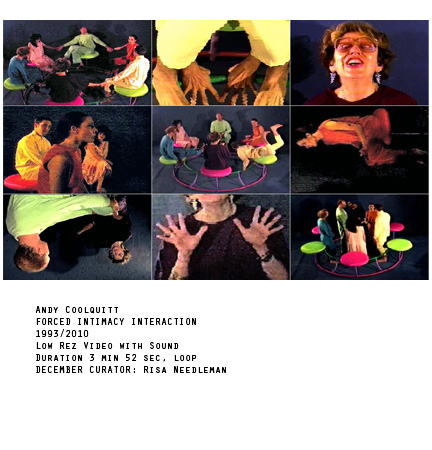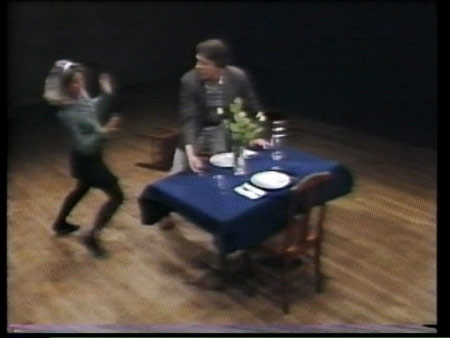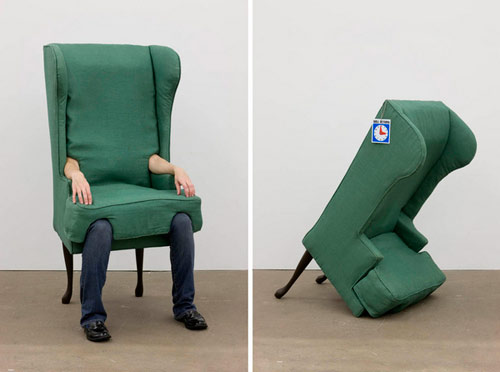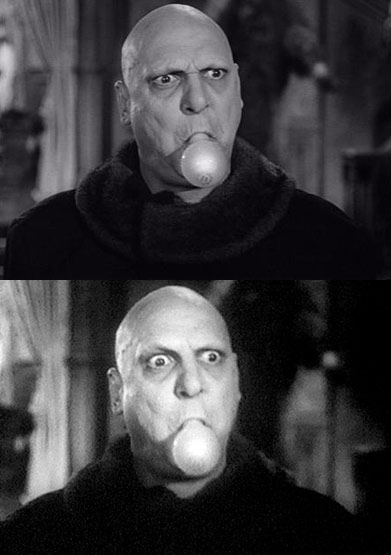Face to Space
December 30th, 2010
Selected by Risa Needleman, the Artist of the Month for December 2010 is Andy Coolquitt, who lives and works in both New York and Austin, Texas and is represented in NYC by Lisa Cooley Fine Art. For his AMC project, Andy resurrects the video component from a theatrical, multimedia installation originally exhibited in 1993 at the University of Texas Gallery.
MB: Is Forced Intimacy Interaction the documentation of a performance? If so, can you tell me more about the context and venue?
AC: It is a re-edit of the video portion from an installation titled 2001 WET SHAFTS: FORCED INTIMACY INTERACTION, 1993. In the original installation, two video monitors were mounted on a large curved wall which functioned sort of like flats. The installation functioned much like a TV set, with this round furniture/sculpture placed on a multi-colored mosaic of old shag carpet, pieced together to form a sort of star burst pattern. The curved wall was totally covered in a collage of found images of food (Slurpee ads/Betty Crocker recipe cards), porn (gay/straight/bi), playing cards, educational flash cards, high school team sports group shots, and a few old posters I had on my bedroom wall as a teenager. The idea was that it was hastily designed by an out-of-touch TV producer to simulate a teenage boy’s bedroom interior, albeit one with a quite advanced sense of visual culture. Anyway, the monitors were mounted about seven feet off the ground with these home-made brackets, so the vibe was sort of like a cross between a fantasy sex room and a sports bar. The mise en scene was simply designed to locate the furniture/sculpture within an environment that would encourage the viewer to “use” it. So the two monitors were playing a synchronized loop of what I considered a users’ guide…instructions of two different ways the viewer could imagine themselves, and hopefully actually sit on the thing. In 1993 in Austin, Texas, it was still pretty difficult to get people to touch anything having to do with art, so if the work seems excessively manipulative now, well – it was.
MB: So the video demonstrates how a group of people might activate the installation. All of that presupposes that visitors will arrive in groups. How would a lonely individual apprehend and engage this work? Would there be a possibility of interaction?
AC: When we are alone we interact with the monitors, with the furniture, the carpet, the walls…the total environment. In this case, these elements are heightened to suggest the manipulative possibilities…to affect our body physically, to imagine a level of intimacy outside of our comfort zone… spandex fabric is very slippery… friction is created automatically.
MB: The work seems to encompass intimacy on many different levels, yet the audible dialogue of the video is generic or at least highly conventional. Most the the dialogue includes perfunctory greetings or tangential concerns. Is the viewer expected to customize these exchanges? To fill in the blanks?
AC: The dialogue is taken from a scene in 2001: A Space Odyssey. In the scene, a group of doctors are discussing a possible outbreak of an epidemic on a distant planet called Clavius. The American doctor, Haywood Floyd, has information about the epidemic but is unwilling to share this information to the other doctors. When pressed on the issue, Doctor Floyd literally recoils in hesitation, visually as well as verbally. This dialogue, taken out of its original context, illustrates a certain type of reticence towards intimacy which counters the grunts and moans of orgasm in the porno soundtrack. The idea is to illustrate two exaggerated examples of intimacy, almost two polar opposites, and let the viewer find their comfort zone somewhere in between.
MB: How does this examination of intimacy continue into your current work, such as the sculptures with light bulbs? In their narrow profiles and attraction to walls, I find myself thinking more about solitude or isolation.
AC: I’m interested in revisiting this work from 1993, in isolating and re-editing the video portion into a single channel work, to view it through the lens of the current production, as if I were just being introduced to the new work and moving backward to see where it came from. The concerns are similar, but with the new work there is an attempt to synthesize all this messy business into the tightest package. The residue of intimacy, of a previous performance is built-in, but much more understated. The older I get, the less I want to instruct the viewer. But hopefully the new sculptures still “work” in the same way. There’s still an attempt to push the work into the subconscious, to come in from the back door.




